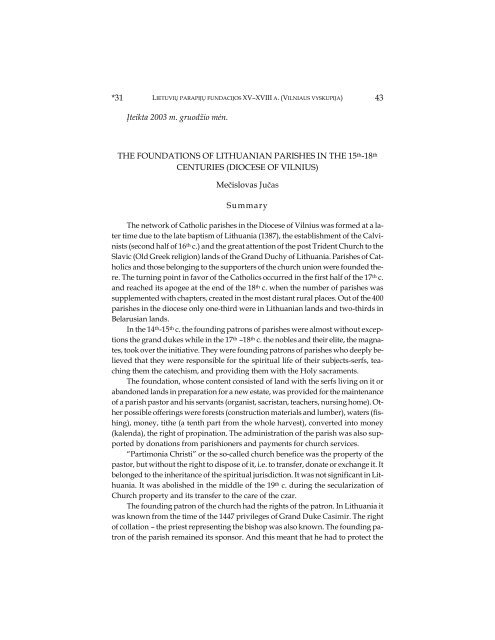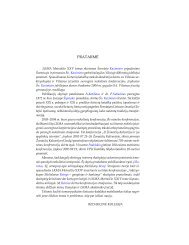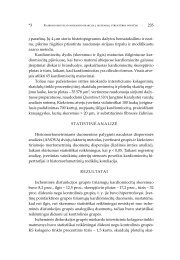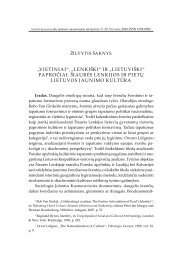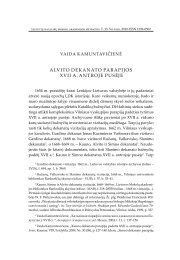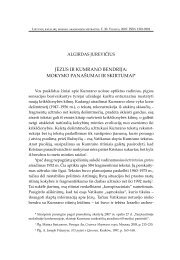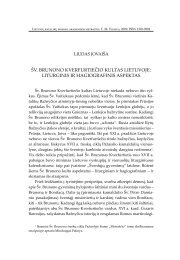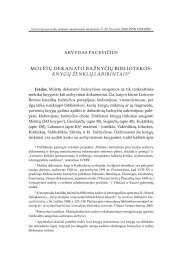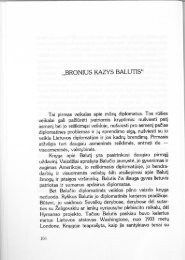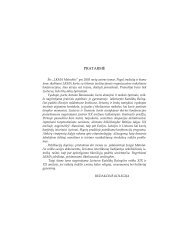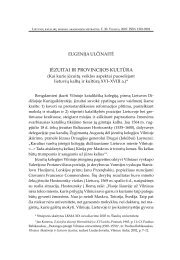- Page 1 and 2: 3 PRATARMĖ Pateikiame skaitytojams
- Page 3 and 4: 5 LIETUVIŲ KATALIKŲ MOKSLO AKADEM
- Page 5 and 6: *3 TURINYS 7 ИВАН ЛЕКЛЕР
- Page 7 and 8: *5 TURINYS 9 VYSK. DR. JONAS BORUTA
- Page 9: Moksliniai straipsniai
- Page 12 and 13: 14 HABIL.DR. MEČISLOVAS JUČAS *2
- Page 14 and 15: 16 HABIL.DR. MEČISLOVAS JUČAS *4
- Page 16 and 17: 18 HABIL.DR. MEČISLOVAS JUČAS *6
- Page 18 and 19: 20 HABIL.DR. MEČISLOVAS JUČAS *8
- Page 20 and 21: 22 HABIL.DR. MEČISLOVAS JUČAS *10
- Page 22 and 23: Parapija ir bažnyčios patrocinija
- Page 24 and 25: Parapija ir bažnyčios patrocinija
- Page 26 and 27: Parapija ir bažnyčios patrocinija
- Page 28 and 29: Parapija ir bažnyčios patrocinija
- Page 30 and 31: Parapija ir bažnyčios patrocinija
- Page 32 and 33: Parapija ir bažnyčios patrocinija
- Page 34 and 35: Parapija ir bažnyčios patrocinija
- Page 36 and 37: Parapija ir bažnyčios patrocinija
- Page 38 and 39: Parapija ir bažnyčios patrocinija
- Page 42 and 43: 44 HABIL.DR. MEČISLOVAS JUČAS *32
- Page 44 and 45: 46 JURGITA LIUTVINAITĖ *2 Įvadas.
- Page 46 and 47: 48 JURGITA LIUTVINAITĖ *4 Katalika
- Page 48 and 49: 50 JURGITA LIUTVINAITĖ *6 krikšto
- Page 50 and 51: 52 JURGITA LIUTVINAITĖ *8 reformat
- Page 52 and 53: 54 JURGITA LIUTVINAITĖ *10 krusti
- Page 54 and 55: 56 JURGITA LIUTVINAITĖ *12 kartą
- Page 56 and 57: 58 JURGITA LIUTVINAITĖ *14 4 lente
- Page 58 and 59: 60 JURGITA LIUTVINAITĖ *16 būtų
- Page 60 and 61: 62 JURGITA LIUTVINAITĖ *18 Šv. Ko
- Page 62 and 63: 64 JURGITA LIUTVINAITĖ *20 4. XIX
- Page 65 and 66: 67 LIETUVIŲ KATALIKŲ MOKSLO AKADE
- Page 67 and 68: *3 KATALIKŲ INICIATYVA: PIRMIEJI S
- Page 69 and 70: *5 KATALIKŲ INICIATYVA: PIRMIEJI S
- Page 71 and 72: *7 KATALIKŲ INICIATYVA: PIRMIEJI S
- Page 73 and 74: *9 KATALIKŲ INICIATYVA: PIRMIEJI S
- Page 75 and 76: *11 KATALIKŲ INICIATYVA: PIRMIEJI
- Page 77 and 78: 79 LIETUVIŲ KATALIKŲ MOKSLO AKADE
- Page 79 and 80: *3 TEOLOGINĖS ŽMOGAUS GYVENIMO PR
- Page 81 and 82: *5 TEOLOGINĖS ŽMOGAUS GYVENIMO PR
- Page 83 and 84: *7 TEOLOGINĖS ŽMOGAUS GYVENIMO PR
- Page 85 and 86: *9 TEOLOGINĖS ŽMOGAUS GYVENIMO PR
- Page 87 and 88: *11 TEOLOGINĖS ŽMOGAUS GYVENIMO P
- Page 89 and 90: *13 TEOLOGINĖS ŽMOGAUS GYVENIMO P
- Page 91 and 92:
*15 TEOLOGINĖS ŽMOGAUS GYVENIMO P
- Page 93 and 94:
*17 TEOLOGINĖS ŽMOGAUS GYVENIMO P
- Page 95 and 96:
*19 TEOLOGINĖS ŽMOGAUS GYVENIMO P
- Page 97 and 98:
*21 TEOLOGINĖS ŽMOGAUS GYVENIMO P
- Page 99 and 100:
*23 TEOLOGINĖS ŽMOGAUS GYVENIMO P
- Page 101 and 102:
*25 TEOLOGINĖS ŽMOGAUS GYVENIMO P
- Page 103 and 104:
*27 TEOLOGINĖS ŽMOGAUS GYVENIMO P
- Page 105 and 106:
*29 TEOLOGINĖS ŽMOGAUS GYVENIMO P
- Page 107 and 108:
*31 TEOLOGINĖS ŽMOGAUS GYVENIMO P
- Page 109 and 110:
*33 TEOLOGINĖS ŽMOGAUS GYVENIMO P
- Page 111 and 112:
*35 TEOLOGINĖS ŽMOGAUS GYVENIMO P
- Page 113 and 114:
*37 TEOLOGINĖS ŽMOGAUS GYVENIMO P
- Page 115 and 116:
*39 TEOLOGINĖS ŽMOGAUS GYVENIMO P
- Page 117 and 118:
*41 TEOLOGINĖS ŽMOGAUS GYVENIMO P
- Page 119 and 120:
*43 TEOLOGINĖS ŽMOGAUS GYVENIMO P
- Page 121 and 122:
*45 TEOLOGINĖS ŽMOGAUS GYVENIMO P
- Page 123 and 124:
LIETUVIŲ KATALIKŲ MOKSLO AKADEMIJ
- Page 125 and 126:
*3 ATSIMINIMAI APIE RAŠYTOJĄ IR P
- Page 127 and 128:
*5 ATSIMINIMAI APIE RAŠYTOJĄ IR P
- Page 129 and 130:
*7 ATSIMINIMAI APIE RAŠYTOJĄ IR P
- Page 131 and 132:
*9 ATSIMINIMAI APIE RAŠYTOJĄ IR P
- Page 133 and 134:
*11 ATSIMINIMAI APIE RAŠYTOJĄ IR
- Page 135 and 136:
*13 ATSIMINIMAI APIE RAŠYTOJĄ IR
- Page 137 and 138:
*15 ATSIMINIMAI APIE RAŠYTOJĄ IR
- Page 139 and 140:
*17 ATSIMINIMAI APIE RAŠYTOJĄ IR
- Page 141 and 142:
*19 ATSIMINIMAI APIE RAŠYTOJĄ IR
- Page 143 and 144:
*21 ATSIMINIMAI APIE RAŠYTOJĄ IR
- Page 145 and 146:
*23 ATSIMINIMAI APIE RAŠYTOJĄ IR
- Page 147 and 148:
*25 ATSIMINIMAI APIE RAŠYTOJĄ IR
- Page 149 and 150:
*27 ATSIMINIMAI APIE RAŠYTOJĄ IR
- Page 151 and 152:
*29 ATSIMINIMAI APIE RAŠYTOJĄ IR
- Page 153 and 154:
*31 ATSIMINIMAI APIE RAŠYTOJĄ IR
- Page 155 and 156:
*33 ATSIMINIMAI APIE RAŠYTOJĄ IR
- Page 157 and 158:
*35 ATSIMINIMAI APIE RAŠYTOJĄ IR
- Page 159 and 160:
*37 ATSIMINIMAI APIE RAŠYTOJĄ IR
- Page 161 and 162:
*39 ATSIMINIMAI APIE RAŠYTOJĄ IR
- Page 163 and 164:
*41 ATSIMINIMAI APIE RAŠYTOJĄ IR
- Page 165 and 166:
*43 ATSIMINIMAI APIE RAŠYTOJĄ IR
- Page 167 and 168:
*45 ATSIMINIMAI APIE RAŠYTOJĄ IR
- Page 169 and 170:
*47 ATSIMINIMAI APIE RAŠYTOJĄ IR
- Page 171 and 172:
*49 ATSIMINIMAI APIE RAŠYTOJĄ IR
- Page 173 and 174:
*51 ATSIMINIMAI APIE RAŠYTOJĄ IR
- Page 175 and 176:
*53 ATSIMINIMAI APIE RAŠYTOJĄ IR
- Page 177 and 178:
*55 ATSIMINIMAI APIE RAŠYTOJĄ IR
- Page 179 and 180:
*57 ATSIMINIMAI APIE RAŠYTOJĄ IR
- Page 181 and 182:
LIETUVIŲ KATALIKŲ MOKSLO AKADEMIJ
- Page 183 and 184:
*3 TEOLOGIJOS-FILOSOFIJOS FAKULTETA
- Page 185 and 186:
*5 TEOLOGIJOS-FILOSOFIJOS FAKULTETA
- Page 187 and 188:
*7 TEOLOGIJOS-FILOSOFIJOS FAKULTETA
- Page 189 and 190:
*9 TEOLOGIJOS-FILOSOFIJOS FAKULTETA
- Page 191 and 192:
*11 TEOLOGIJOS-FILOSOFIJOS FAKULTET
- Page 193 and 194:
*13 TEOLOGIJOS-FILOSOFIJOS FAKULTET
- Page 195 and 196:
*15 TEOLOGIJOS-FILOSOFIJOS FAKULTET
- Page 197 and 198:
*17 TEOLOGIJOS-FILOSOFIJOS FAKULTET
- Page 199 and 200:
*19 TEOLOGIJOS-FILOSOFIJOS FAKULTET
- Page 201 and 202:
*21 TEOLOGIJOS-FILOSOFIJOS FAKULTET
- Page 203 and 204:
*23 TEOLOGIJOS-FILOSOFIJOS FAKULTET
- Page 205 and 206:
*25 TEOLOGIJOS-FILOSOFIJOS FAKULTET
- Page 207 and 208:
*27 TEOLOGIJOS-FILOSOFIJOS FAKULTET
- Page 209 and 210:
*29 TEOLOGIJOS-FILOSOFIJOS FAKULTET
- Page 211 and 212:
*31 TEOLOGIJOS-FILOSOFIJOS FAKULTET
- Page 213:
*33 TEOLOGIJOS-FILOSOFIJOS FAKULTET
- Page 216 and 217:
218 LINA STRIOKAITĖ *2 Be abejo,
- Page 218 and 219:
220 LINA STRIOKAITĖ *4 tas įvyki
- Page 220 and 221:
222 LINA STRIOKAITĖ *6 tobulu Kris
- Page 222 and 223:
224 LINA STRIOKAITĖ *8 autentišku
- Page 224 and 225:
226 LINA STRIOKAITĖ *10 name pasta
- Page 226 and 227:
228 LINA STRIOKAITĖ *12 vienuolių
- Page 228 and 229:
230 LINA STRIOKAITĖ *14 5. Vienuol
- Page 230 and 231:
232 LINA STRIOKAITĖ *16 Eusebijas
- Page 232 and 233:
234 DR. KAZIMIERAS VALANČIUS, IEVA
- Page 234 and 235:
236 DR. KAZIMIERAS VALANČIUS, IEVA
- Page 236 and 237:
238 DR. KAZIMIERAS VALANČIUS, IEVA
- Page 238 and 239:
240 DR. KAZIMIERAS VALANČIUS, IEVA
- Page 241 and 242:
LIETUVIŲ KATALIKŲ MOKSLO AKADEMIJ
- Page 243 and 244:
LIETUVIŲ KATALIKŲ MOKSLO AKADEMIJ
- Page 245 and 246:
*3 КОНФЕССИОНАЛЬНАЯ
- Page 247 and 248:
*5 КОНФЕССИОНАЛЬНАЯ
- Page 249 and 250:
*7 КОНФЕССИОНАЛЬНАЯ
- Page 251 and 252:
*9 КОНФЕССИОНАЛЬНАЯ
- Page 253 and 254:
LIETUVIŲ KATALIKŲ MOKSLO AKADEMIJ
- Page 255 and 256:
*3 UNITŲ BAŽNYČIOS VALDYMAS RUSI
- Page 257 and 258:
*5 UNITŲ BAŽNYČIOS VALDYMAS RUSI
- Page 259 and 260:
*7 UNITŲ BAŽNYČIOS VALDYMAS RUSI
- Page 261 and 262:
*9 UNITŲ BAŽNYČIOS VALDYMAS RUSI
- Page 263 and 264:
*11 UNITŲ BAŽNYČIOS VALDYMAS RUS
- Page 265 and 266:
*13 UNITŲ BAŽNYČIOS VALDYMAS RUS
- Page 267 and 268:
*15 UNITŲ BAŽNYČIOS VALDYMAS RUS
- Page 269 and 270:
LIETUVIŲ KATALIKŲ MOKSLO AKADEMIJ
- Page 271 and 272:
*3 СОПРОТИВЛЕНИЕ ДЕ
- Page 273 and 274:
*5 СОПРОТИВЛЕНИЕ ДЕ
- Page 275 and 276:
*7 СОПРОТИВЛЕНИЕ ДЕ
- Page 277 and 278:
*9 СОПРОТИВЛЕНИЕ ДЕ
- Page 279 and 280:
*11 СОПРОТИВЛЕНИЕ ДЕ
- Page 281 and 282:
*13 СОПРОТИВЛЕНИЕ ДЕ
- Page 283 and 284:
*15 СОПРОТИВЛЕНИЕ ДЕ
- Page 285:
*17 СОПРОТИВЛЕНИЕ ДЕ
- Page 288 and 289:
290 HABIL. DR. ALDONA PRAŠMANTAIT
- Page 290 and 291:
292 HABIL. DR. ALDONA PRAŠMANTAIT
- Page 292 and 293:
294 HABIL. DR. ALDONA PRAŠMANTAIT
- Page 294 and 295:
296 HABIL. DR. ALDONA PRAŠMANTAIT
- Page 296 and 297:
298 HABIL. DR. ALDONA PRAŠMANTAIT
- Page 298 and 299:
300 HABIL. DR. ALDONA PRAŠMANTAIT
- Page 300 and 301:
302 HABIL. DR. ALDONA PRAŠMANTAIT
- Page 302 and 303:
304 HABIL. DR. ALDONA PRAŠMANTAIT
- Page 305 and 306:
LIETUVIŲ KATALIKŲ MOKSLO AKADEMIJ
- Page 307 and 308:
*3 РОЛЬ ИМПЕРСКОЙ ВЛ
- Page 309 and 310:
*5 РОЛЬ ИМПЕРСКОЙ ВЛ
- Page 311 and 312:
*7 РОЛЬ ИМПЕРСКОЙ ВЛ
- Page 313 and 314:
*9 РОЛЬ ИМПЕРСКОЙ ВЛ
- Page 315 and 316:
*11 РОЛЬ ИМПЕРСКОЙ В
- Page 317 and 318:
*13 РОЛЬ ИМПЕРСКОЙ В
- Page 319 and 320:
*15 РОЛЬ ИМПЕРСКОЙ В
- Page 321 and 322:
*17 РОЛЬ ИМПЕРСКОЙ В
- Page 323 and 324:
*19 РОЛЬ ИМПЕРСКОЙ В
- Page 325 and 326:
*21 РОЛЬ ИМПЕРСКОЙ В
- Page 327 and 328:
*23 РОЛЬ ИМПЕРСКОЙ В
- Page 329 and 330:
*25 РОЛЬ ИМПЕРСКОЙ В
- Page 331 and 332:
*27 РОЛЬ ИМПЕРСКОЙ В
- Page 333 and 334:
*29 РОЛЬ ИМПЕРСКОЙ В
- Page 335 and 336:
*31 РОЛЬ ИМПЕРСКОЙ В
- Page 337 and 338:
*33 РОЛЬ ИМПЕРСКОЙ В
- Page 339 and 340:
*35 РОЛЬ ИМПЕРСКОЙ В
- Page 341 and 342:
*37 РОЛЬ ИМПЕРСКОЙ В
- Page 343 and 344:
*39 РОЛЬ ИМПЕРСКОЙ В
- Page 345:
*41 РОЛЬ ИМПЕРСКОЙ В
- Page 348 and 349:
350 Д-Р.ГРИГОРИЙ ПОТА
- Page 350 and 351:
352 Д-Р.ГРИГОРИЙ ПОТА
- Page 352 and 353:
354 Д-Р.ГРИГОРИЙ ПОТА
- Page 354 and 355:
356 Д-Р.ГРИГОРИЙ ПОТА
- Page 356 and 357:
358 Д-Р.ГРИГОРИЙ ПОТА
- Page 358 and 359:
360 Д-Р.ГРИГОРИЙ ПОТА
- Page 360 and 361:
362 Д-Р.ГРИГОРИЙ ПОТА
- Page 362 and 363:
364 Д-Р.ГРИГОРИЙ ПОТА
- Page 364 and 365:
366 Д-Р.ГРИГОРИЙ ПОТА
- Page 367 and 368:
LIETUVIŲ KATALIKŲ MOKSLO AKADEMIJ
- Page 369 and 370:
*3 «ЛИТОВСКИЙ ПАРАД
- Page 371 and 372:
*5 «ЛИТОВСКИЙ ПАРАД
- Page 373 and 374:
*7 «ЛИТОВСКИЙ ПАРАД
- Page 375:
*9 «ЛИТОВСКИЙ ПАРАД
- Page 378 and 379:
380 DR. REGINA LAUKAITYTĖ *2 Vient
- Page 380 and 381:
382 DR. REGINA LAUKAITYTĖ *4 Stač
- Page 382 and 383:
384 DR. REGINA LAUKAITYTĖ *6 apsis
- Page 384 and 385:
386 DR. REGINA LAUKAITYTĖ *8 ginč
- Page 386 and 387:
388 DR. REGINA LAUKAITYTĖ *10 cerk
- Page 388 and 389:
390 DR. REGINA LAUKAITYTĖ *12 nyč
- Page 390 and 391:
392 DR. REGINA LAUKAITYTĖ *14 į s
- Page 392 and 393:
394 DR. REGINA LAUKAITYTĖ *16 ла
- Page 394 and 395:
396 DR. REGINA LAUKAITYTĖ *18 до
- Page 396 and 397:
398 DR. REGINA LAUKAITYTĖ *20 wing
- Page 398 and 399:
400 Д-Р. СЕРГЕЙ ТОКТЬ
- Page 400 and 401:
402 Д-Р. СЕРГЕЙ ТОКТЬ
- Page 402 and 403:
404 Д-Р. СЕРГЕЙ ТОКТЬ
- Page 404 and 405:
406 Д-Р. СЕРГЕЙ ТОКТЬ
- Page 406 and 407:
408 Д-Р. СЕРГЕЙ ТОКТЬ
- Page 408 and 409:
410 Д-Р. СЕРГЕЙ ТОКТЬ
- Page 410 and 411:
412 Д-Р. СЕРГЕЙ ТОКТЬ
- Page 412 and 413:
414 Д-Р. СЕРГЕЙ ТОКТЬ
- Page 414 and 415:
416 Д-Р. СЕРГЕЙ ТОКТЬ
- Page 416 and 417:
418 Д-Р. СЕРГЕЙ ТОКТЬ
- Page 418 and 419:
420 Д-Р. СЕРГЕЙ ТОКТЬ
- Page 420 and 421:
422 Д-Р. А.Ф. СМАЛЯНЧУ
- Page 422 and 423:
424 Д-Р. А.Ф. СМАЛЯНЧУ
- Page 424 and 425:
426 Д-Р. А.Ф. СМАЛЯНЧУ
- Page 426 and 427:
428 Д-Р. А.Ф. СМАЛЯНЧУ
- Page 428 and 429:
430 Д-Р. А.Ф. СМАЛЯНЧУ
- Page 430 and 431:
432 Д-Р. А.Ф. СМАЛЯНЧУ
- Page 432 and 433:
434 Д-Р. А.Ф. СМАЛЯНЧУ
- Page 434 and 435:
436 Д-Р. А.Ф. СМАЛЯНЧУ
- Page 436 and 437:
438 Д-Р. А.Ф. СМАЛЯНЧУ
- Page 438 and 439:
440 Д-Р. ВАЛЕНТИНА ЯН
- Page 440 and 441:
442 Д-Р. ВАЛЕНТИНА ЯН
- Page 442 and 443:
444 Д-Р. ВАЛЕНТИНА ЯН
- Page 444 and 445:
446 Д-Р. ВАЛЕНТИНА ЯН
- Page 446 and 447:
448 Д-Р. ПОЛ ВЕРТ *2 од
- Page 448 and 449:
450 Д-Р. ПОЛ ВЕРТ *4 то
- Page 450 and 451:
452 Д-Р. ПОЛ ВЕРТ *6 он
- Page 452 and 453:
454 Д-Р. ПОЛ ВЕРТ *8 Гу
- Page 454 and 455:
456 Д-Р. ПОЛ ВЕРТ *10 ны
- Page 456 and 457:
458 Д-Р. ПОЛ ВЕРТ *12 Та
- Page 458 and 459:
460 Д-Р. ПОЛ ВЕРТ *14 до
- Page 460 and 461:
462 Д-Р. ПОЛ ВЕРТ *16 Та
- Page 462 and 463:
464 Д-Р. ПОЛ ВЕРТ *18 ро
- Page 464 and 465:
466 Д-Р. ПОЛ ВЕРТ *20 во
- Page 466 and 467:
468 Д-Р. ПОЛ ВЕРТ *22 та
- Page 468 and 469:
470 Д-Р. ПОЛ ВЕРТ *24 Вв
- Page 470 and 471:
472 Д-Р. ПОЛ ВЕРТ *26 ап
- Page 472 and 473:
474 Д-Р. ПОЛ ВЕРТ *28 ос
- Page 475 and 476:
LIETUVIŲ KATALIKŲ MOKSLO AKADEMIJ
- Page 477 and 478:
*3 К ВОПРОСУ О МЕТОД
- Page 479 and 480:
*5 К ВОПРОСУ О МЕТОД
- Page 481 and 482:
*7 К ВОПРОСУ О МЕТОД
- Page 483 and 484:
*9 К ВОПРОСУ О МЕТОД
- Page 485 and 486:
*11 К ВОПРОСУ О МЕТОД
- Page 487 and 488:
LIETUVIŲ KATALIKŲ MOKSLO AKADEMIJ
- Page 489 and 490:
LIETUVIŲ KATALIKŲ MOKSLO AKADEMIJ
- Page 491 and 492:
*3 JUOZO BRAZAIČIO PILIETINĖ RAI
- Page 493 and 494:
*5 JUOZO BRAZAIČIO PILIETINĖ RAI
- Page 495 and 496:
*7 JUOZO BRAZAIČIO PILIETINĖ RAI
- Page 497 and 498:
LIETUVIŲ KATALIKŲ MOKSLO AKADEMIJ
- Page 499 and 500:
*3 LIETUVOS INTELEKTUALŲ ELITAS LE
- Page 501 and 502:
*5 LIETUVOS INTELEKTUALŲ ELITAS LE
- Page 503 and 504:
LIETUVIŲ KATALIKŲ MOKSLO AKADEMIJ
- Page 505 and 506:
*3 JUOZAS BRAZAITIS - VALSTYBININKA
- Page 507 and 508:
*5 JUOZAS BRAZAITIS - VALSTYBININKA
- Page 509 and 510:
LIETUVIŲ KATALIKŲ MOKSLO AKADEMIJ
- Page 511 and 512:
*3 LIETUVOS LAIKINOJI VYRIAUSYBĖ 5
- Page 513 and 514:
*5 LIETUVOS LAIKINOJI VYRIAUSYBĖ 5
- Page 515 and 516:
*7 LIETUVOS LAIKINOJI VYRIAUSYBĖ 5
- Page 517 and 518:
*9 LIETUVOS LAIKINOJI VYRIAUSYBĖ 5
- Page 519 and 520:
*11 LIETUVOS LAIKINOJI VYRIAUSYBĖ
- Page 521 and 522:
*13 LIETUVOS LAIKINOJI VYRIAUSYBĖ
- Page 523 and 524:
*15 LIETUVOS LAIKINOJI VYRIAUSYBĖ
- Page 525:
*17 LIETUVOS LAIKINOJI VYRIAUSYBĖ
- Page 528 and 529:
530 DR. MINDAUGAS BLOZNELIS *2 Šio
- Page 530 and 531:
532 DR. MINDAUGAS BLOZNELIS *4 dr.
- Page 532 and 533:
534 DR. MINDAUGAS BLOZNELIS *6 vien
- Page 534 and 535:
536 DR. MINDAUGAS BLOZNELIS *8 tą
- Page 536 and 537:
538 DR. MINDAUGAS BLOZNELIS *10 nis
- Page 538 and 539:
540 DR. MINDAUGAS BLOZNELIS *12 Ta
- Page 540 and 541:
542 DR. MINDAUGAS BLOZNELIS *14 Pri
- Page 542 and 543:
544 DR. MINDAUGAS BLOZNELIS *16 Ben
- Page 544 and 545:
546 DR. MINDAUGAS BLOZNELIS *18 JUO
- Page 546 and 547:
548 DR. ARŪNAS BUBNYS *2 vaites ir
- Page 548 and 549:
550 DR. ARŪNAS BUBNYS *4 cinį sus
- Page 550 and 551:
552 DR. ARŪNAS BUBNYS *6 svarbiaus
- Page 553 and 554:
LIETUVIŲ KATALIKŲ MOKSLO AKADEMIJ
- Page 555 and 556:
*3 LITERATŪROLOGAS JUOZAS BRAZAITI
- Page 557 and 558:
*5 LITERATŪROLOGAS JUOZAS BRAZAITI
- Page 559:
*7 LITERATŪROLOGAS JUOZAS BRAZAITI
- Page 562 and 563:
564 DR. JUOZAS BANIONIS *2 Antri -
- Page 564 and 565:
566 DR. JUOZAS BANIONIS *4 do ir mo
- Page 566 and 567:
568 DR. JUOZAS BANIONIS *6 Ketvirta
- Page 569 and 570:
LIETUVIŲ KATALIKŲ MOKSLO AKADEMIJ
- Page 571 and 572:
*3 JUOZAS BRAZAITIS - LKMA ISTORIJO
- Page 573 and 574:
*5 JUOZAS BRAZAITIS - LKMA ISTORIJO
- Page 575 and 576:
*7 JUOZAS BRAZAITIS - LKMA ISTORIJO
- Page 577:
LIETUVIŲ KATALIKŲ MOKSLO AKADEMIJ
- Page 580 and 581:
582 AKAD. HABIL. DR. ANTANAS TYLA *
- Page 582 and 583:
584 AKAD. HABIL. DR. ANTANAS TYLA *
- Page 585 and 586:
LIETUVIŲ KATALIKŲ MOKSLO AKADEMIJ
- Page 587 and 588:
*3 VYSKUPO VINCENTO BORISEVIČIAUS
- Page 589 and 590:
*5 VYSKUPO VINCENTO BORISEVIČIAUS
- Page 591 and 592:
*7 VYSKUPO VINCENTO BORISEVIČIAUS
- Page 593 and 594:
*9 VYSKUPO VINCENTO BORISEVIČIAUS
- Page 595 and 596:
*11 VYSKUPO VINCENTO BORISEVIČIAUS
- Page 597 and 598:
*13 VYSKUPO VINCENTO BORISEVIČIAUS
- Page 599 and 600:
*15 VYSKUPO VINCENTO BORISEVIČIAUS
- Page 601 and 602:
*17 VYSKUPO VINCENTO BORISEVIČIAUS
- Page 603 and 604:
*19 VYSKUPO VINCENTO BORISEVIČIAUS
- Page 605 and 606:
*21 VYSKUPO VINCENTO BORISEVIČIAUS
- Page 607 and 608:
*23 VYSKUPO VINCENTO BORISEVIČIAUS
- Page 609 and 610:
*25 VYSKUPO VINCENTO BORISEVIČIAUS
- Page 611 and 612:
*27 VYSKUPO VINCENTO BORISEVIČIAUS
- Page 613 and 614:
*29 VYSKUPO VINCENTO BORISEVIČIAUS
- Page 615 and 616:
*31 VYSKUPO VINCENTO BORISEVIČIAUS
- Page 617 and 618:
*33 VYSKUPO VINCENTO BORISEVIČIAUS
- Page 619 and 620:
*35 VYSKUPO VINCENTO BORISEVIČIAUS
- Page 621 and 622:
*37 VYSKUPO VINCENTO BORISEVIČIAUS
- Page 623 and 624:
*39 VYSKUPO VINCENTO BORISEVIČIAUS
- Page 625 and 626:
*41 VYSKUPO VINCENTO BORISEVIČIAUS
- Page 627 and 628:
*43 VYSKUPO VINCENTO BORISEVIČIAUS
- Page 629 and 630:
*45 VYSKUPO VINCENTO BORISEVIČIAUS
- Page 631 and 632:
*47 VYSKUPO VINCENTO BORISEVIČIAUS
- Page 633 and 634:
*49 VYSKUPO VINCENTO BORISEVIČIAUS
- Page 635 and 636:
*51 VYSKUPO VINCENTO BORISEVIČIAUS
- Page 637 and 638:
*53 VYSKUPO VINCENTO BORISEVIČIAUS
- Page 639 and 640:
*55 VYSKUPO VINCENTO BORISEVIČIAUS
- Page 641 and 642:
*57 VYSKUPO VINCENTO BORISEVIČIAUS
- Page 643 and 644:
*59 VYSKUPO VINCENTO BORISEVIČIAUS
- Page 645 and 646:
*61 VYSKUPO VINCENTO BORISEVIČIAUS
- Page 647 and 648:
*63 VYSKUPO VINCENTO BORISEVIČIAUS
- Page 649 and 650:
*65 2 PRIEDAS VYSKUPO VINCENTO BORI
- Page 651 and 652:
LIETUVIŲ KATALIKŲ MOKSLO AKADEMIJ
- Page 653 and 654:
*3 KUNIGŲ DALYVAVIMAS GINKLUOTOJO
- Page 655:
*5 KUNIGŲ DALYVAVIMAS GINKLUOTOJO
- Page 659 and 660:
LIETUVIŲ KATALIKŲ MOKSLO AKADEMIJ
- Page 661 and 662:
*3 XX-XXI A. PRADŽIOS IŠKILIŲJŲ
- Page 663 and 664:
*5 XX-XXI A. PRADŽIOS IŠKILIŲJŲ
- Page 665 and 666:
*7 XX-XXI A. PRADŽIOS IŠKILIŲJŲ
- Page 667 and 668:
*9 XX-XXI A. PRADŽIOS IŠKILIŲJŲ
- Page 669 and 670:
*11 XX-XXI A. PRADŽIOS IŠKILIŲJ
- Page 671 and 672:
*13 XX-XXI A. PRADŽIOS IŠKILIŲJ
- Page 673 and 674:
*15 XX-XXI A. PRADŽIOS IŠKILIŲJ
- Page 675 and 676:
*17 XX-XXI A. PRADŽIOS IŠKILIŲJ
- Page 677 and 678:
*19 XX-XXI A. PRADŽIOS IŠKILIŲJ
- Page 679 and 680:
*21 XX-XXI A. PRADŽIOS IŠKILIŲJ
- Page 681 and 682:
*23 XX-XXI A. PRADŽIOS IŠKILIŲJ
- Page 683 and 684:
*25 XX-XXI A. PRADŽIOS IŠKILIŲJ
- Page 685 and 686:
*27 XX-XXI A. PRADŽIOS IŠKILIŲJ
- Page 687 and 688:
*29 XX-XXI A. PRADŽIOS IŠKILIŲJ
- Page 689 and 690:
*31 XX-XXI A. PRADŽIOS IŠKILIŲJ
- Page 691 and 692:
*33 XX-XXI A. PRADŽIOS IŠKILIŲJ
- Page 693 and 694:
*35 XX-XXI A. PRADŽIOS IŠKILIŲJ
- Page 695:
Kronika
- Page 698 and 699:
700 KRONIKA *2 vi (Ispanija), ryši
- Page 700 and 701:
702 KRONIKA *4 9. Paliatyvi slauga,
- Page 702 and 703:
704 KRONIKA *6 gyvenimą, laipsniš
- Page 704 and 705:
706 KRONIKA *8 Moralinės ligos gal
- Page 706 and 707:
708 KRONIKA *10 Katalikų Bažnyči
- Page 708 and 709:
710 KRONIKA *12 MORAL DISEASES AND
- Page 710 and 711:
712 KRONIKA *14 priimti visus moksl
- Page 712 and 713:
714 KRONIKA *16 4. Vizitai į pasau
- Page 714 and 715:
716 KRONIKA *18 sis žodis“ (apie
- Page 716 and 717:
718 KRONIKA *20 Kitos visuomeninės
- Page 718 and 719:
720 KRONIKA *22 1949-1950 m.m. mok
- Page 720 and 721:
722 KRONIKA *24 Būsimasis profesor
- Page 722 and 723:
724 KRONIKA *26 rantė, vėliau dė
- Page 724 and 725:
726 KRONIKA *28 vidurinio mokslo mi
- Page 726 and 727:
728 KRONIKA *30 KUN. VINCAS VALKAVI
- Page 728 and 729:
730 KRONIKA *32 1970 m. seminarijos
- Page 731:
733 Recenzijos
- Page 734 and 735:
736 RECENZIJOS *2 pietryčius ir ry
- Page 736 and 737:
738 RECENZIJOS *4 ir buvusi imperij
- Page 738 and 739:
740 RECENZIJOS *6 Tokių seniausių
- Page 740 and 741:
742 RECENZIJOS *8 jog tyrimo objekt
- Page 742 and 743:
744 RECENZIJOS *10 dvasinės formac
- Page 744 and 745:
746 RECENZIJOS *12 požiūriu Regul
- Page 746 and 747:
748 RECENZIJOS *14 Apie atskirus ka
- Page 748 and 749:
750 RECENZIJOS *16 siai, gerokai si
- Page 750 and 751:
752 RECENZIJOS *18 bajorų mokykloj
- Page 752 and 753:
754 RECENZIJOS *20 Naujų duomenų
- Page 754 and 755:
756 RECENZIJOS *22 šiuo metu verti
- Page 756 and 757:
LIETUVIŲ KATALIKŲ MOKSLO AKADEMIJ
- Page 758 and 759:
760 ASMENVARDŽIŲ RODYKLĖ *3 Buko
- Page 760 and 761:
762 ASMENVARDŽIŲ RODYKLĖ *5 Yča
- Page 762 and 763:
764 ASMENVARDŽIŲ RODYKLĖ *7 Laba
- Page 764 and 765:
766 ASMENVARDŽIŲ RODYKLĖ *9 Orlo
- Page 766 and 767:
768 ASMENVARDŽIŲ RODYKLĖ *11 Sem
- Page 768 and 769:
770 ASMENVARDŽIŲ RODYKLĖ *13 Urb
- Page 770 and 771:
772 ASMENVARDŽIŲ RODYKLĖ *15 Г
- Page 772 and 773:
774 ASMENVARDŽIŲ RODYKLĖ *17 Т
- Page 774:
NURODYMAI LKMA METRAŠČIO AUTORIAM


